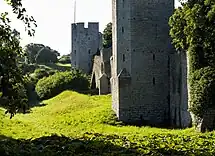| War on Gotland | |||||||||
|---|---|---|---|---|---|---|---|---|---|
 City wall of Visby | |||||||||
| |||||||||
| Belligerents | |||||||||
|
Supported by Wendish towns |
Supported by Livonian knights | ||||||||
| Commanders and leaders | |||||||||
| Unknown |
Olof Rangvalds Peter Hardings Mickel Takstens Olof Gartarve Tomas Bilder Häfleif Qvinnegårda | ||||||||
| Strength | |||||||||
| Unknown | Unknown | ||||||||
| Casualties and losses | |||||||||
| Heavy | Heavy | ||||||||
The War on Gotland was an armed conflict between the rural farmers of Gotland and the burghers of Visby, two battles were fought, one at Högebro, at which the Burghers emerged victorious[2] and Roma, in which neither side won.[2] However, the war concluded with the Treaty of Gotland which was mediated by Magnus III.[3]
Background
In the 1280s, the city of Visby started construction of a large wall around its perimeters to prevent the rural people of Gotland to trade in the city,[4] and the establishment of a tax, which was one of the main reasons for the war,[5] the farmers asked the German army chief in Livonia for help, it's theorized that him and a few knights actually travelled to Gotland to help the farmers in their fight against the Burghers.[6][5]
Prelude
With the backing of Livonian knights, the farmers of Gotland armed themselves and started their march toward Visby, intending on attacking the city.[7] In response, the burghers of Visby also mobilized their forces.[7]
Attack on Visby
When the peasants reached Visby, their assault wasn't expected by the city's defenders,[8] the peasants marched into Visby and the plunderers marched along the streets until they returned with their loot. The townspeople and their allies quickly organized for a counterattack.[8] The city's troops consisted mostly of hired German mercenaries, however they were trained and combat ready.[8]
Battle of Högebro
At Högebro, the two sides met, the battle was a hard-fought one which lasted the entire day, most of the battle was on the side of the farmers,[7] but the weapons of the Burghers were better and they were victorious later.[7] The defeated farmers retreated into a forest which the burghers followed, this resulted in many being captured and taken to Sjönem. However, the farmers did not lose hope and mobilized for another battle.
Battle of Roma
At Roma monastery, which stands 2 miles from Visby, another battle occurred between the burghers and farmers. On both sides there were high casualties[7] however the battle was inconclusive, after the battle the priests of Roma monastery intervened and through their indefatigable endeavor managed to broker a temporary armistice between the two sides.[9]
But peace was not made there, The peasants pulled out time after time, and it was with great difficulty that the priests were able to repel the renewal of battle. Finally, Bodel Kallin and Gerved of Martebo declared on behalf of the peasants that Edvard von Lode and several knights wanted to enter the city themselves and confirm the peace.[7] That was how things stood, when the news reached King Magnus about what was occurring on the island, without hesitation, the king sent word that diplomats for both parties should come to him.
Conclusion
In August 1288, King Magnus III summoned representatives from both sides to Nyköping to broker peace between the two. The envoys admitted that the burghers of Visby had offended the king, when they undertook, unprompted by him, to fortify their town and wage war against the peasants. They therefore paid 2,000 marks of silver and 500 mark assorted silver in penance.[7]
If, after this time, any disagreement arose between Visby and the peasants, the matter would be referred to the king first, before the burghers escalated it into any hostility against the peasants. However, no such notification would be needed if such a fierce attack by the peasants took place that violence had to be met by violence.
Furthermore, any complaints by the peasants to the king of Sweden would not be hindered from reaching him by the burghers in any way.[9] Only the king of Sweden would be their master, and if the peasants should ever fall into such a predicament as to choose another master, Visby would, with all the city was capable of, strive against it. And should the common people in any way prove rebellious against the king, the burghers, as soon as they received knowledge of it and were requested, would keep their gates open to the king and leave the king all possible help against the peasants.
References
- ↑ Clapham, Sir John Harold; Power, Eileen (1941). Cambridge Economic History of Europe. CUP Archive. ISBN 9781001518671.
- 1 2 Starbäck, Carl Georg (1885). Berättelser ur svenska historien (in Swedish). F. & G. Beijers Förlag.
- ↑ Harrison, Dick (2011-01-13). Jarlens sekel: En berättelse om 1200-talets sverige (in Swedish). Ordfront. ISBN 978-91-7441-359-5.
- ↑ "Medeltidsstaden -1500". Region Gotland (in Swedish). Retrieved 2023-08-19.
- 1 2 Starbäck, Carl Georg (1885). Berättelser ur svenska historien: Sagoåldern. Medeltiden I., till Kalmare-unionen (in Swedish). F. & G. Beijers.
- ↑ "Inbördeskriget mellan staden och landet 1288". www.gotlandsforsvarshistoria.se. Retrieved 2023-10-09.
- 1 2 3 4 5 6 7 Starbäck, Carl Georg (1885). Berättelser ur svenska historien: Sagoåldern. Medeltiden I., till Kalmare-unionen (in Swedish). F. & G. Beijers.
- 1 2 3 Adolfsson, Mats (2010-12-21). När borgarna brann (in Danish). Natur & Kultur. ISBN 978-91-27-12808-8.
- 1 2 Sundberg, Ulf (1999). Medeltidens Svenska krig (in Swedish) (1st ed.). Stockholm: Hjalmarson & Högberg. p. 95. ISBN 9189080262.